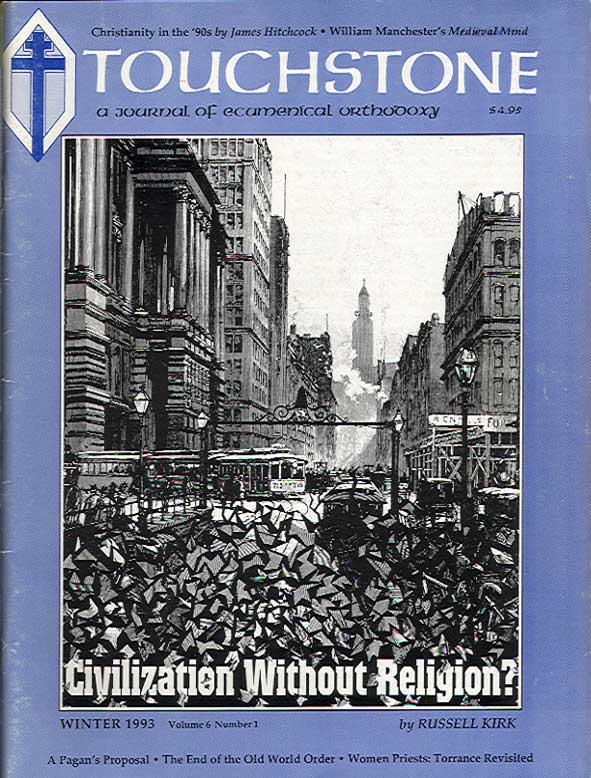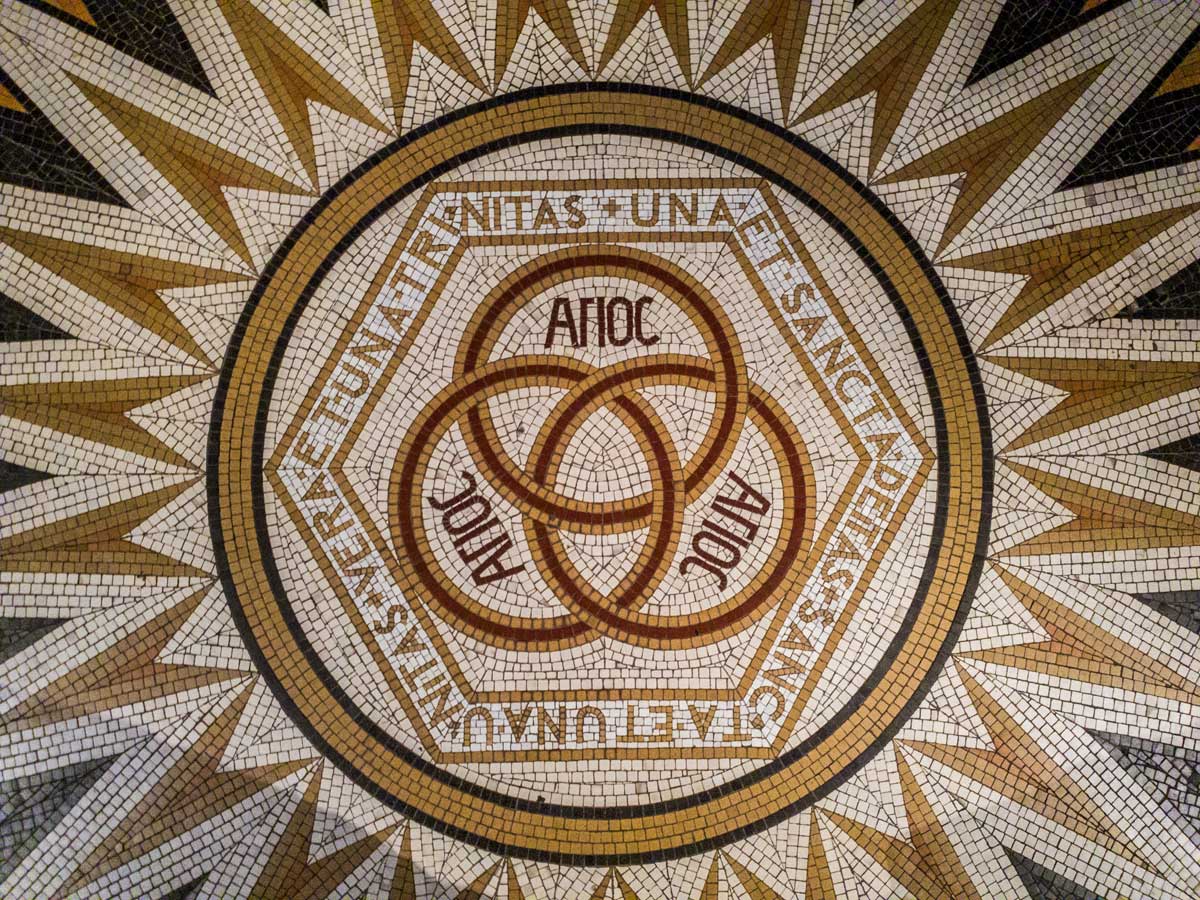Women Priests: History & Theology
A Response to Thomas F. Torrance
by Patrick Henry Reardon
By submitting this article in response to Dr. Thomas Torrance I intend, in the first place, to pay my respects. When I read his recent argument favoring the ordination of women (“The Ministry of Women,” Touchstone 5.4, Fall 1992), I felt that the author had to be answered. Not that the lines of his argument are either especially persuasive or particularly original. I believe that they are neither, having used some of them myself back when I was an Evangelical Protestant and thought women’s ordination an idea whose time had come. But Dr. Torrance is Dr. Torrance, after all, and anything theological he has to say is, on this implicit point of merit, worth paying attention to.
In fact he is certainly receiving attention. The article in question has also been published as a pamphlet in Scotland and in A Festschrift for Penelope Jamieson, the new woman bishop of the Anglicans down in New Zealand. Any study supporting the priesting of women has the current advantage of riding a wave, perhaps even a tidal wave. As I comment on the article by Torrance, I beg indulgence also to remark, from time to time, on some of his fellow surfers.
Let me say at once that, unlike my dear and delightful friend, S. M. Hutchens (“God, Gender and the Pastoral Office” in that same issue of Touchstone), I cannot summon the energy to mount a charge against the priestly ordination of women. A little later, I shall float a hint as to why that matter is not a realistic question for debate at my current address, the Eastern Orthodox Catholic Church.
The following response, therefore, will not form a case against women’s ordination. I hope only to show that Torrance’s own arguments in favor of that practice were ill-conceived and very badly made. His approach was two-fold, historical and doctrinal. In the first he adduced documentation that the ordination of women was in fact done by the Church at certain periods of history, and in the second he endeavored theologically to justify a return to that discipline today. His first argument was inductive and requires a point by point address. His second and more properly theological argument was largely deductive and can be more briefly rejoined by a critical analysis of its major premise.
Presbytera
The real controversy, the one most addressed by Torrance, concerns the priesthood or presbyterate. Let it be said up front that those who would appeal to ancient precedent to justify the ordination of women to the ministry of presbyter in the Church are faced with a fairly daunting task. Torrance concedes that “there is no canonical record of any office of woman presbyters.” Indeed there is no literary record of any kind to that effect.
Oh, that all proponents of women’s ordination were so honest about the lack of literary evidence. For example, a 1987 article in the Priscilla Papers (Volume 1, no. 4) claimed that “St. Cyprian writes [in Epistle 75.10.5] of a female presbyter [elder] in Cappadocia [also part of modern Turkey] in the mid-230s.” If true, of course, that would seem to be game point and match, for what fool would contest the great African Father? A fine shade of doubt faintly shadows the mind at this point, nevertheless, and I wonder how, having studied St. Cyprian assiduously from my youth, I had failed to distinguish this fairly big detail. Well, I didn’t. The letter in question was actually sent to the saintly bishop of Carthage by Firmilian of Caesarea reporting on what he regarded as the pretentious (deceperat . . . simularet . . .usurpans), irregular (ab ecclesiastica regula),and even scandalous (nequissimus daemon per mulierem) activities of some local woman whom he managed to call just about everything but a presbyter. A delicate and gentle tact pleads that no more be said about this so-called evidence from the third century.
Getting slightly, but only slightly, more serious, we know that there are quite a few early epigraphic references to this or that presbytera (priestess), and there is no shortage of feminist archaeologists to make the most of them. These tomb inscriptions, found all around the Mediterranean basin, would perhaps make a cogent argument for women’s ordination if we did not already know exactly what a presbytera was during the earliest centuries of Christianity: an elderly woman, often a widow, under the care of the Church. There is no evidence whatsoever that it referred to an ordained woman. Consequently, in calling St. Priscilla a “presbytera officiating along with the presbyteroi in the central act of the worship of the church,” Torrance employed the word in a sense unknown either in the Christian literature of the period or in any clear epigraphic examples. Salva reverentia, this was an unwarranted, eccentric and misleading liberty.
One finds also a few early epigraphic instances of the word presbytis, but once again we already know from Titus 2:3—5 and other canonical documents that this simply means an elderly woman. In the Apostolic Constitutions the term seems synonymous with presbytera in the sense of a widow or other older woman in the special care of the Church.
Torrance himself refers to presbytides, a title signifying women who had certain special functions in the worship of the Church, but he cites the testimony of Epiphanius that these women were not to be regarded as priestesses. Evidently because they functioned that way among the fourth-century Montanists, Canon 11 of the Council of Laodicea finally suppressed the title (Hopko, 61—74).
Something more must be said about the later history of presbytera, of which Torrance admits that it “was sometimes used (and still is in Greece) to refer to the wife of a presbyter.” Indeed, we should give this usage more serious attention. I am not aware of literary instances of it before the sixth century. The earliest witness I know of is Canon 19 of the First Council of Tours (ca 567), which speaks of a presbyter cum sua presbytera, “priest with his priestess.” A nearly contemporary example of this usage is found in the Dialogues (4.11) of Pope St. Gregory I.
The origins of presbytera in reference to a priest’s wife, nonetheless, were evidently quite a bit earlier. When our literature finally does bear witness to the custom in the sixth century, the masculine term presbyter was already in the process of being replaced in Greek by hiereus and in Latin by sacerdos. It is very important to note, however, that these words, hiereus and sacerdos, were not feminized by custom; only the older term presbyter was. That changing of the masculine noun presbyter reflected an alteration of accent in the theology of the priesthood during that period, but the significant fact for our investigation is that there was no corresponding change in the feminine form of the word. A presbytera was simply the wife of a priest; if I may express it so, the word had only a sociological, not a theological, reference. At no time was any woman ordained a presbytera; she became one when her husband was ordained a priest.
Furthermore, this very preservation of the word presbytera in reference to a priest’s wife certainly bears witness to its antiquity and general acceptance. Some feminist archaeologists, as though they were proving something, actually present slide shows with perhaps a score of tomb inscriptions bearing the word presbytera. Well, there are doubtless thousands more such inscriptions to be found out there, but they add zero to the feminist case.
It is inadequate to say then, as Torrance does, that it “was sometimes used” to refer to the wife of a priest. After the fifth century that was the most expected and normal meaning of the word in both Greek and Latin; the select references to this usage from the sixth century onwards fill more than a column of Du Cange’s standard lexicon of medieval Latin. From the earlier part of that same period there are still, to be sure, a few instances where the word refers to widows of the Church, and occasionally, but more especially among the Greeks, it designated an abbess. Still, the dominant meaning of presbytera after the fifth century was (and has remained) the wife of a priest. I am aware of no evidence, prior to the Slavic missions, that a priest’s wife was ever called by any name other than presbytera or, after the seventh-century Moslem conquest of Syria, the Arabic precise equivalent, khoureeye. At absolutely no point in the first thousand years of Christian history do we find testimony of presbytera designating an ordained person in the Church.
Another remark is in order here with respect to the presbytera. She was very often the mother of a priest as well as a priest’s wife. While I cannot speak for Italy or Gaul, where efforts were being made to force celibacy on the clergy, we know that in many villages of Greece and Syria (and later among the Slavs), the priesthood tended to stay in the same family for a number of generations. A presbytera in such a situation acquired a twofold claim to the name. One observes even today the common Arabic title of address: “mother of the priest,” um-l-khoury.
Expressing candor at the risk of appearing haughty, let me submit that the exegetical problem here is one of historical continuity. For practical purposes, only the Eastern Orthodox Christians nowadays know by immediate social experience what a presbytera is, whether she is called a popadija (Serbian), a panyi (Carpathian and Ukrainian), a matushka (Russian), a khoureeye (Syrian) or a presvytera (Greek). (My parishioners are proud to address my wife as khoureeye, “priestess,” but I fear she would do damage to the hands that tried to ordain her.) This specific sociological creature called the presbytera almost does not exist today outside of Orthodoxy, even when, as among the Anglicans, the parish priest is a married man. During the first 1,000 years, however, she was an ordinary and anticipated phenomenon in thousands of parish churches.
Because she is culturally alien to them, Western Christians today sometimes fail to identify the presbytera when they find evidence of her in history. If I am permitted to say it abruptly and with no desire to find fault, my meaning is this: the Roman Catholics got rid of the priest’s wife, and then the Protestants got rid of the priest. So at the present moment Western Christians, who are still very deeply divided among themselves as to what ordination theologically means or what exactly a person is being ordained to, are simultaneously speculating whether women themselves should be ordained. Thus, every time another tomb is discovered bearing the inscription presbytera, a certain number of them stand around congratulating one another on how their evidence is piling up, while the others wring their hands and wonder how to dam the tidal wave. It is a waste of time.
Back to the Catacombs
So Torrance and other proponents of women’s ordination, deprived of the faintest filament of support for their case in either literary or monumental sources, turn to the iconography of the early Church, a move that this Eastern Orthodox Christian would frankly like to see become a trend. Torrance takes us to Rome, there to examine a very early mural in the Catacomb of St. Priscilla. It depicts seven figures seated at a table, and these he describes as seven presbyters celebrating the Eucharist in a catacomb. Torrance, whose eyesight must be infinitely keener than mine, went so far as to identify two of these figures (“presumably”) as the biblical Aquila and Priscilla, and Touchstone reproduced the picture.
Well, right now I am recalling some wonderfully enjoyable afternoons of yesteryear when, after a long northbound bus ride on the Via Nomentana, I would stand in reverence before that mural and the other fascinating examples of primitive iconography in the Catacomb of St. Priscilla. Doubtless my respect for him over the years may prompt me to regard Torrance as a visionary of sorts, but let me tell you that I never during those afternoons detected anything on that wall comparable to what he claims to behold there.
Even now, looking at a photograph of that fresco over and over again, I discern no trace of what he and some other people say they see. Not terribly clear in every respect, the picture has been the subject of numerous conjectures and since Davin in 1892, even caricatures. Some viewers could find no male figures in the picture at all (Irvin, 6f.), while Henri Leclercq, who describes them more generally as personages, sees a bearded male, évidemment le president, to our left (Dictionnaire 2.2092). It was the presence of at least one woman at the table that ruled out an early interpretation that the portrayal was of the seven disciples eating at the Sea of Tiberias (John 21:12—23).
Even if this were a realistic picture of the early Eucharist at Rome, it would add nothing to Torrance’s argument for women’s ordination. Even on that conjecture, it is just not possible to say that anyone at that table is a female presbyter “concelebrating” the Eucharist. That notion cannot be dated prior to some two decades ago, I think, when feminism began its intense feeding frenzy. The world’s most eminent liturgical archaeologists since 1885, including Rossi, Wilpert, and Leclercq, studied the fresco from every angle without spotting anything of the sort. That was the year, by the way, that this catacomb was first named for St. Priscilla, largely because scholars believed that she was in Rome (see Romans 16:3) when the catacomb was originally dug on the property of the senator Pudens. To my knowledge, Torrance is the first viewer to spot both Aquila and Priscilla in the mural itself, a feat in whose emulation I have contracted severe eye strain.
But is this supposed to be a realistic portrayal of any actual celebration of the Eucharist? There are reasons for thinking that it is not. According to Justin Martyr, the Eucharist at Rome was celebrated standing and in prayer, whereas in this scene we are presented with seven figures sitting there at a table talking and gesticulating to one another in what appear to be three separate conversations. (One admits readily that random discourse and other spontaneous pleasantries have also been known to break out from time to time among the less devout during the Eucharist itself, even in some of the local parishes of my area, but we rarely memorialize the event in a mural.)
There are scores of extant catacomb icons showing Christians at prayer, and those all conform to what we know about the usual posture of Christian prayer from several literary sources: figures standing, arms elevated and extended in cruciform, eyes raised. Two good examples are the pictures from the Septuagint Book of Daniel—the praying Susanna and the three boys in the furnace—which are found right there in the same Capella Graeca as the table scene we are talking about. In this latter icon, however, there is no resemblance whatsoever to those other artistic and literary witnesses. All the figures are seated, not one eye in the painting is cast upward, not a single hand raised even to shoulder height.
If we are not looking at a realistic portrait of the Eucharist, still it would be rash to conclude that there is nothing Eucharistic about it. The picture is somewhat complex. We observe that its imagery is drawn in part from the Last Supper, in part from the Multiplication of the Loaves; one notes the fish along with the bread and chalice at the table, as well as the seven baskets of fragments (see Mark 8:8 and 20) off to the sides. This all suggests a combining, a “com-penetration” if you will, of images from two Gospel scenes. Indeed, the later presence of elevaties oculis in coelum (“with eyes raised to heaven”), a direct quotation from the Multiplication narrative in Mark 6:41, within the actual Institution Account in the venerable Roman Liturgy, is a striking testimony of how easily the Roman Christians combined the two Gospel scenes.
I believe that this is an icon of the Messianic Banquet, of which the Multiplication of Loaves was a foreshadowing, and the eucharist an anticipation. The seven figures, whom I take to be symbolic of the Church in her eschatological fullness, are doing exactly what Jesus said his disciples would do in the kingdom—they are sitting and feasting. The picture is less a portrayal of how early second-century Christians conducted themselves at the Eucharist than of how they hoped to behave themselves in heaven.
Theodora Episcopa
But now let us continue to follow the lead of Torrance south through the streets of Rome from the Catacomb of St. Priscilla to the Church of St. Praxedes. There we find a ninth-century mosaic depicting four female “saints” who were dear to Pope Pascal I (817-824), a fierce opponent of iconoclasm. The heads of three of these women are each shrined in a round nimbus, signifying that they were already venerated as saints in the liturgical calendar of the Church: St. Praxedes, the Virgin Mary, and (supposes Henri Leclercq, who enjoys a kind of infallibility in these matters) St. Prudentiana. The woman on the extreme left is featured with a square nimbus, indicating that she was still alive when the mosaic was made.
This last woman was also important to Pope Pascal I; she was his mother, Theodora. (She was not the Empress Theodora, as one might be led to think by the picture that unfortunately accompanied Torrance’s article in Touchstone and which I am sure he did not choose.) Undoubtedly, none of this would solicit our attention in the present discussion on women’s ordination were it not for the inscription to the side of and over her head in the mosaic: Theodora Episcopa [Theodora the Bishopess]. Torrance, convinced now that he has at last discovered the smoking gun, sums up his case: “And so we have papal authority for a woman bishop and an acknowledgment by the pope that he himself was the son of a woman bishop.”
Well, if he insists on grasping for that straw, I am afraid that Torrance’s proposition must simply sink with it. As I will show in a moment, an adequate exegesis of that inscription will necessarily involve some element of reasonable surmise and contextualizing. Torrance’s ipse dixit, however, cannot seriously be called even a conjecture; it is a revisionist bluff, an unfounded affront to everything we know about the ninth century by accepted standards of inference and context. During the period under discussion every ordination canon in force and every ordinal in use presumes that only persons of the male sex are ordained. No feminine noun, adjective or referent is ever employed in those testimonials. Every single contemporary literary reference to a bishop, whether in sermon, treatise, or letter, including those of Pope Pascal himself (Volume 129 of Migne’s Latin Patrology), is masculine. To seize on this one inscription, then, and gratuitously to pretend that it documents the existence of a female bishop at Rome in the ninth century is an embarrassing exercise in ideological fantasy, first advanced, I believe, by Joan Morris in her 1972 hallucination, The Lady was a Bishop.
We are left, nonetheless, with the task of finding out what the word episcopa does mean as it appears over the head of Theodora. Literary references are the first and most obvious place to look for an answer. Here the positive and direct evidence, though materially slight, demolishes Torrance’s thesis. In 813, during Pascal’s priestly and monastic ministry in Rome and just four years before he was made pope, the Second Council of Tours prescribed the following Canon 13: “Let no entourage of women accompany a bishop who does not have a bishopess” (Episcopum episcopam non habentem nulla sequatur turba mulierum). By itself the text is unanswerable proof that an episcopa in ninth-century Latin was understood to be the wife of a bishop.
It has also been suggested that episcopa may likewise have meant “abbess.” I am aware of no evidence supporting this attractive suggestion, however, except the very inscription we are talking about (see the sources cited in Du Cange’s entry episcopa). In our mosaic Theodora does seem to be wearing the coif normally associated with feminine monasticism. (Indeed, that coif was once invoked to argue that Theodora was unmarried and thus not the wife of a bishop! – See Irvin, 6). That the mother of so monastic an enthusiast should have become a nun in her advancing and widowed years would be no surprise. Still, in the absence of supporting testimony, it appears to me a rather shaky business to regard episcopa as the equivalent of abbatissa solely on the basis of this inscription. I would be delighted, nonetheless, to have some medievalist show me wrong.
At the risk of seeming fickle, let me submit one more possibility. In spite of the testimony of the Second Council of Tours cited above, I confess that I am not really convinced that Pope Pascal’s mother was married to a bishop. My suspicion, based on nothing more than what I know of the folk habits of Orthodox Christians, and advanced here with all due discretion, is this: Theodora was called an episcopa or bishopess, simply because she was the mother of the bishop of Rome. As the latter had no wife (the Roman popes and most other bishops having been celibate for quite some time) but did have a popular mother living close at hand, the name episcopa was informally transferred to her by those who held her in high regard. If this was so, episcopa in her case was a name of endearment, charmed with that hint of play and irony that often adorn terms of affection. Pope Pascal’s mother was later remembered as gracious and kind (benignissima genitrix, says a source cited in Du Cange). In his mosaic crafted during her lifetime, then, her son memorialized her with that respectful and affectionate name by which everyone in Rome knew her: the bishopess. It would take another thousand years and a vastly different ecclesiastical context for that title to be so totally misunderstood.
So, at the end, how much archaeological evidence has been found for women’s ordination to the priesthood in the Church of the first thousand years? Zero, and not the faintest fraction more. Those who have sought for solid historical data in its support have come up with just plain zero. Unfortunately, they have often enough then proceeded to multiply their zeros and pretend that they are ready to alter the ministerial structure of the Church.
It would cause me no grand surprise and only small pain to learn that sometime in some ecclesiastical backwater or infrequently visited village, some bishop had sneaked his ordaining hands onto some woman’s head. But the proponents of this most novel of novelties have failed to give us even a single historical example of such a laying on of hands. That has not, however, prevented their impressive display of sleight of hand.
Theological Reasoning
In the second part of his article Torrance advances speculative theological reasons for female presbyteral ordination, commencing with the premise that “there is no intrinsic or theological ground for the exclusion of women.” He accuses opponents of women’s ordination of arguing that “it is only a man who can be an ikon of Christ at the altar,” and then goes on to show why he thinks them wrong.
Torrance hints repeatedly that those who would restrict presbyteral ordination to men alone are not taking seriously the biblical doctrine that both men and women are made in God’s image and likeness. In Christ, he reminds us, there is neither male nor female. So, he argues, “woman as well as man was made in the image of God, and may therefore be said to be an ikon of God as well as man.” This likeness to God, in short, pertains to human nature, not a specific sex. So if “iconography” is a basis for ordination, then the male must not be given preference to the female. I trust that this summary accurately represents the thought of Torrance.
In response let us ask another question: Can a Christian man icon or represent Christ in a way that is not possible for a Christian woman? If the answer to this question is yes, then perhaps there may be a doctrinal basis for ordaining men and not ordaining women. Keep that thought in mind: If the answer is yes—if the Christian man really can icon or represent Christ in a way that a Christian woman cannot—then everything Torrance wrote on this matter by way of theological reflection is beside the point.
If I have correctly understood Torrance, however, his answer to that question must be no. Indeed, it seems to me that he says repeatedly throughout his article that, in this matter of iconing or representing Christ, the male cannot do it in any way not also available to the female. Such representation always has to do exclusively with human nature as such, he contends, and never with a specific sex. Now if that is truly what Torrance is saying, then he is manifestly at odds with Holy Scripture. I take it to be the clear teaching of the New Testament that the Christian man, as male and not simply as person, can represent Christ in some way that the Christian woman cannot.
We are taught in the New Testament that the husband in the Christian family, precisely as husband, can represent Christ in some way that his wife is not able to duplicate (Ephesians 5:21—33), and that this representation has to do with his specific sex. This representation involves his being masculine and not feminine. This representation is further described as one of headship: “the husband is the head of the wife as Christ is head of the Church.” The text here is something of a hard saying in our contemporary setting precisely because it is so clear and so irreducible. It says that the Christian husband, as head of the family, represents Christ who is head of the Church. This representation of Christ in headship pertains to the husband’s specific sex (see also 1 Corinthians 11:3).
Now if that is true, then the answer to the question posed above must be yes: It is possible for the Christian man to icon Christ in a way that is not possible for the Christian woman. And if that is true, then there is a reasonable and possible theological basis for ordaining men and not ordaining women, and thus Torrance’s major premise is eviscerated.
Please understand, I am not making that argument myself; I am simply saying that the argument can be made on a scriptural basis. I am reluctant to craft any such theoretical argument, because I do not want to convey the impression that the Church’s refusal to ordain women is based on some theological study or speculative reflection. That refusal by the Church is not founded on any sort of rational theory excogitated by theologians but on the authority of the living Apostolic Tradition. Quite simply, the ordination of women was not received from Christ and handed down to us by the Apostles. It is an alien intrusion, a meddling with Moabites, and consequently must be numbered among those novelties against which the Bible warns us.
Male headship, however, does raise an important point of Christology and Trinitarian doctrine. Prior to becoming a male in the human race, the eternal Word was already God’s Son, not just his offspring. The fatherhood and the sonship in the Holy Trinity are not simply cultural names. Even if there were no such things as men and women, God would still be Father, Son, and Holy Spirit. Male headship in the Church and in the Christian family then is not an arbitrary arrangement. It has to do with the very being of the God of Christians. Change it and you start to alter that most patriarchal of dogmas: the doctrine of the Trinity.
I hasten to agree with Torrance that sex “may not be read back into the Being of God as Father.” I simply want to insist that God is Father, Son, and Holy Spirit, not something else. If it is erroneous to read sex back into God, then it is at least as wrong to read androgyny or gender-neutrality back into God, and that is exactly what has happened among some Christians who several years ago adopted female ordination. Anyone entertaining doubts on this point is invited to examine the new Methodist service book or the various trial liturgies recently inflicted on some unsuspecting Episcopalians. The theology in those books goes out of its way to portray an androgynous divinity by concentrated and intentional recourse to gender-neutral, feminine, and even animist metaphors with a view to “balancing” the biblical names “Father and Son,” while these latter are only sparsely employed. The books are shocking examples of a modern reluctance to voice the two proclamations given us by the Holy Spirit: “Abba, Father” and “Jesus is Lord.”
Theological Error
Torrance cites with approval George Carey’s much publicized assessment that those who oppose women’s ordination are in “serious theological error.” Well, perhaps so. But we may do well to examine the implications of that assessment. If we are in serious theological error, how did we get that way? We got that way from the previous generation of Christians. Okay, how did they come to be in serious theological error? Apparently they got it from the generation before them, and so forth. A slight difficulty arises here, however, because it is a matter of historical fact that all generations of Orthodox Catholic Christians for roughly 2,000 years have been opposed to the ordination of women. Why? Because of the supposed vestigial Manichaeism of St. Augustine and his alleged sexual hangups? Be serious. Just where did the error come from?
The Last Supper, that’s where. If we are in error, it is penultimately because the Apostles themselves got it wrong. And if the Apostles themselves were in error, they received that error from the One who told them what to do and how to do it. And if that Person was in error, we—those among us who believe him to be the Son of God, the Savior of the world and its only hope—have a rather serious problem on our hands.
That was the whole point of my reference to the neo-paganism of the new Methodist and Episcopalian worship experiments. I trust it will not be a matter of indifference to Torrance that our opposition to women’s ordination springs from a deeply held conviction that the practice itself is a grave act of disobedience and a first, but firm, step toward apostasy. In fact, this was the assessment explicitly asserted by C. S. Lewis several decades ago in a passage that is well known. Lewis argued that ordaining the male sex to minister at the Eucharist has to do with the “correct appearance” (“orthodoxy” in Greek), the proper iconography. Change that appearance, alter that icon, he reasoned, and in due time you are worshipping a different god. That is precisely what we are witnessing today in congregations that were still Christian back when C. S. Lewis spoke his mind.
I see the matter to be every bit as serious as that tiny but notorious fourth-century iota that Athanasius would have died to keep out of the Creed. The adoption of female ordination is regarded by some of us as an implicit but definite challenge to the lordship of Christ and the finality of his word, those very same concerns devoutly cultivated and always maintained uppermost in the adorned and spacious mind of Thomas Forsyth Torrance.•
In a future article Patrick Reardon intends to give a critical analysis of the hermeneutical presuppositions of Torrance et al from an Eastern Orthodox theological perspective.
BIBLIOGRAPHY
Dictionnaire: Henri Leclercq, several articles in Volumes 2 and 14 of Dictionnaire d’Archéologie chrétienne et de Liturgie, Paris: Letouzey, 1935, 1948.
Hauke: Manfred Hauke, Women in the Priesthood?, San Francisco: Ignatius, 1988.
Hopko: Thomas Hopko, Women and the Priesthood, Crestwood: St. Vladimir’s, 1983.
Irvin: Dorothy Irvin, “Archaeology Supports Women’s Ordination,” The Witness, February 1980.
This is part of a series of articles with Thomas F. Torrance and Patrick
Henry Reardon. See below:
Pt. 1 — The Ministry of Women: An Argument for the Ordination of Women by Thomas F. Torrance
Pt. 2 — Women
Priests: A Response to Thomas F. Torrance by Patrick Henry Reardon (this article)
Pt. 3 — On the Ordination of Women: A Correspondence Between Thomas F. Torrance and Patrick Henry Reardon
See also these articles by Touchstone senior editor S. M. Hutchens:
God,
Gender, and the Pastoral Office and Mystical
Theology
and the Sublimation of Gender
Patrick Henry Reardon is pastor emeritus of All Saints Antiochian Orthodox Church in Chicago, Illinois, and the author of numerous books, including, most recently, Out of Step with God: Orthodox Christian Reflections on the Book of Numbers (Ancient Faith Publishing, 2019).
subscription options
Order
Print/Online Subscription

Get six issues (one year) of Touchstone PLUS full online access including pdf downloads for only $39.95. That's only $3.34 per month!
Order
Online Only
Subscription

Get a one-year full-access subscription to the Touchstone online archives for only $19.95. That's only $1.66 per month!
bulk subscriptions
Order Touchstone subscriptions in bulk and save $10 per sub! Each subscription includes 6 issues of Touchstone plus full online access to touchstonemag.com—including archives, videos, and pdf downloads of recent issues for only $29.95 each! Great for churches or study groups.
Transactions will be processed on a secure server.
more on ministry from the online archives
more from the online archives
calling all readers
Please Donate
"There are magazines worth reading but few worth saving . . . Touchstone is just such a magazine."
—Alice von Hildebrand
"Here we do not concede one square millimeter of territory to falsehood, folly, contemporary sentimentality, or fashion. We speak the truth, and let God be our judge. . . . Touchstone is the one committedly Christian conservative journal."
—Anthony Esolen, Touchstone senior editor












